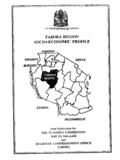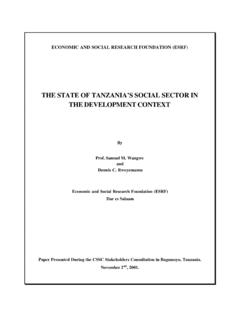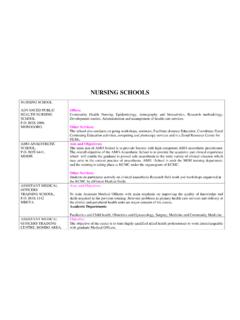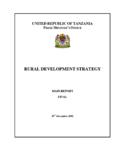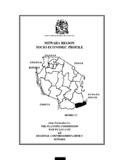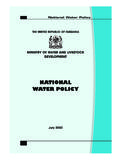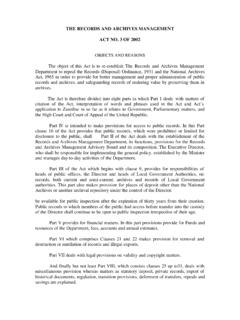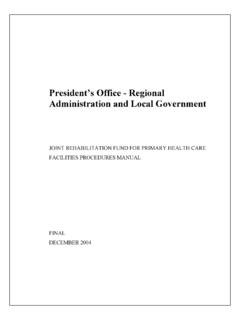Transcription of UNITED REPUBLIC OF TANZANIA - Tzonline
1 UNITED REPUBLIC OF TANZANIA . NATIONAL STRATEGY FOR GROWTH AND. REDUCTION OF POVERTY. (NSGRP II). [Summarized Version]. Ministry of Finance and Economic Affairs April 15, 2010. CHAPTER I: INTRODUCTION AND BACKGROUND. The National Strategy for Growth and Reduction of Poverty in TANZANIA (NSGRP II), modelled on its predecessor MKUKUTA I, is committed to economic growth, superior quality of life, overall peace, financial stability and high educational achievement. This strategy dovetails perfectly with the international 2015 Millennium Development Goals, which target the reduction of poverty, hunger, disease, illiteracy, environmental degradation, and discrimination against women. The agenda fosters effective participation of the civil society, the private sector, and other stakeholders to allow all Tanzanians to thrive.
2 The Ministry of Finance and Economic Affairs will coordinate the implementation of the Strategy, in collaboration with other Ministries, Departments and Agencies (MDGs) across the nation. The National Poverty Eradication Strategy (NPES) was formulated in 1998 to coordinate poverty eradication initiatives. The resulting Poverty Reduction Strategy Paper (PRSP). helped to accelerate the pace of poverty reduction between 2001 and 2005 and led to the adoption of MKUKUTA I. Efforts focused on reaching across governmental sectors, geographic regions, and income-generating activities to maximise synergies; integrating the Millennium Development Goals into actionable strategies; utilising a five-year incubation period to monitor and track successful execution; emphasising the role of economic growth and good governance in poverty reduction; and addressing vulnerability, human rights and social protection issues in poverty reduction.
3 MKUKUTA II is informed by evaluative studies on the impact of MKUKUTA I and lessons learned from the global financial and economic crisis of 2008-2009 as well as studies conducted. A decrease in foreign trade (especially exports) and financial flows (especially foreign direct investment) slowed down TANZANIA 's economic growth although recent recovery, partly due to a rescue plan targeting key industries, is evidenced by increasing demand both globally and regionally for Tanzanian exports, new opportunities, due to (ICT) developments and cross-border commerce with other East African countries. The Strategy utilised a collective and inclusive process of input and review by key constituencies.
4 The seven chapters detailing the MUKUTA II Strategy are comprised of: 1. Major Goals and Background 2. Status of Poverty, Challenges, and Opportunities 3. Strategy Framework 4. Strategy Components 5. Implementation Plan 6. Ongoing Monitoring and Evaluation 7. Financing Modalities CHAPTER II: CHALLENGES AND OPPORTUNITIES. Poverty and the Challenges of Income Distribution TANZANIA 's poverty reduction strategy delivered impressive growth in gross domestic product (GDP) during the past decade. Despite this, income distribution did not change significantly. TANZANIA 's economy has created 630,000 new jobs annually since 2001, mainly in the informal sector, yet the unemployment rate remains at about percent.
5 Employment in higher income-generating jobs is key to helping people move out of poverty. To make economic improvements, addressing the challenges in the below areas will be key. Areas to address are categorised in the following clusters: Cluster I: Growth and Reduction of Income Poverty will focus on: Macroeconomic Management: For macroeconomic management with regard to inflation, national debt, credit, Foreign Direct Investment, and external balance a focus needs to be made on: Improving public finance management Keeping spending in line with national development priorities Designing supportive monetary policy to ensure macroeconomic stability Agriculture: Agriculture remains the place where the majority of Tanzanians earn their incomes which means there is immense potential for increasing agricultural productivity.
6 Additionally, fisheries, mining, manufacturing and tourism are industries that have a lot of potential for growing the Tanzanian economy but have challenges that need to be addressed. Each industry needs to see improvements in: Quality control Enforcement of regulations Preparedness for environmental hazards Land-use efficiencies Training Financing Cost of business regulation Efficiencies and improvements of infrastructure Efficiencies in processes Cluster II: Quality of Life and Social Well Being Despite significant MKUKUTA I advances in social services with regard to education, health care, clean water, sanitation and social protection initiatives, improvement in the quality of life and social wellbeing for Tanzanians remains one of the most formidable challenges facing the country.
7 Below are key areas of social well-being that need to be addressed to help achieve the MKUKUTA II goals: Education Health Malaria, TB, HIV and AIDS: Life Expectancy and Mortality Rates Sanitary and hygienic water supply Shelter and Human Settlement Social Protection and well-being of vulnerable groups Good governance and accountability with the structures and systems in place Equality of gender inclusion within society and income-generating activity Cluster III: Good Governance and Accountability Achievements and a focus on the below areas will greatly increase the quality of the country's good-governance systems and worth and positively affect growth: Effective Public Service Framework Equitable Allocation of National Resources Governance in Natural Resources Human Rights Culture and Development with focus on preserving history and values of the culture Challenges toward Implementation For successful implementation during MKUKUTA II to take place, a focus on proper implementation, prioritizing needs, follow- through on reform, and proper budgeting prior to implementation will be critical for success.
8 Additionally, proper monitoring and evaluation are key for the plans in place to be effective. These oversights should be done through proper reporting and reporting analysis with an additional need for involving dialogue into the evaluation process. An additional challenge to meeting MKUKUTA II goals is mobilisation of resources with regard to financing. Creating funding to be able to address the above industry needs, improve upon the challenges in place and take advantage of opportunity things requires both an internal effort to mobilise Tanzanians to increase income, and an external initiative to secure international private financing by some of TANZANIA 's most promising enterprises through syndicated bank loans.
9 An analysis of the status, challenges and opportunities presented in this chapter, indicates that initial policy should be directed towards developing TANZANIA 's economic growth through the creation of a detailed long term growth and development plan and promoting private sector growth. Opportunity for innovation exists through the creation of new strategies for meeting needs through the Independent Service Authorities (ISA) and public private partnerships. CHAPTER III: STRATEGY FRAMEWORK. There are 10 guiding principles of MKUKUTA II for implementing the objectives of both the Long Term Growth and Development Plan (LGDP) and DV2025. These are: 1. Stimulate broad-based growth to substantially reduce poverty.
10 2. Improve implementation effectiveness and outcomes through better use of resources. 3. Create a critical mass of skills through enhanced Human Resource Development (HRD) efforts to build labour force capabilities needed for successful implementation. 4. Harness public-private-community partnerships to stimulate strategic investment, privately or in partnership with the government. 5. Promote wide citizen participation to generate massive private sector growth. 6. Use science and technology, as well as creativity and innovation, as the basis for socio-economic transformation to improve the quality of life, raise productivity and build healthy competition within TANZANIA 's private sector and in regional and international marketplaces.
